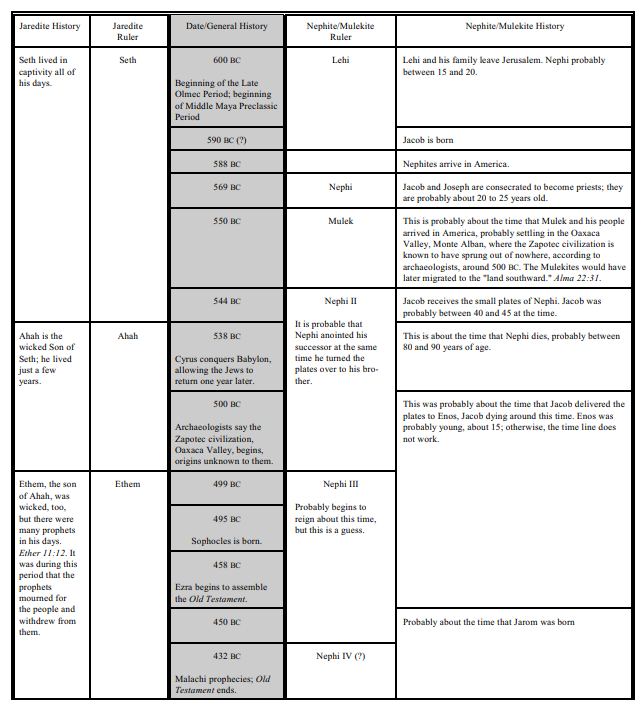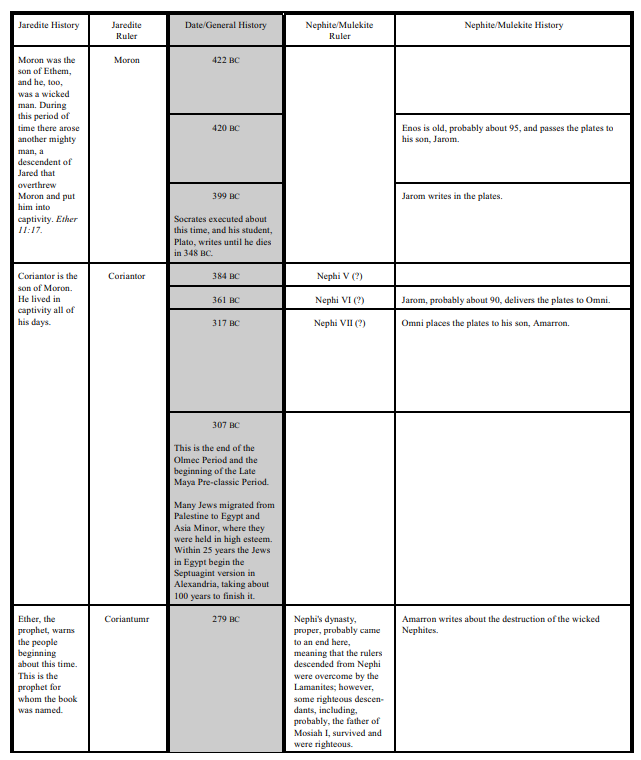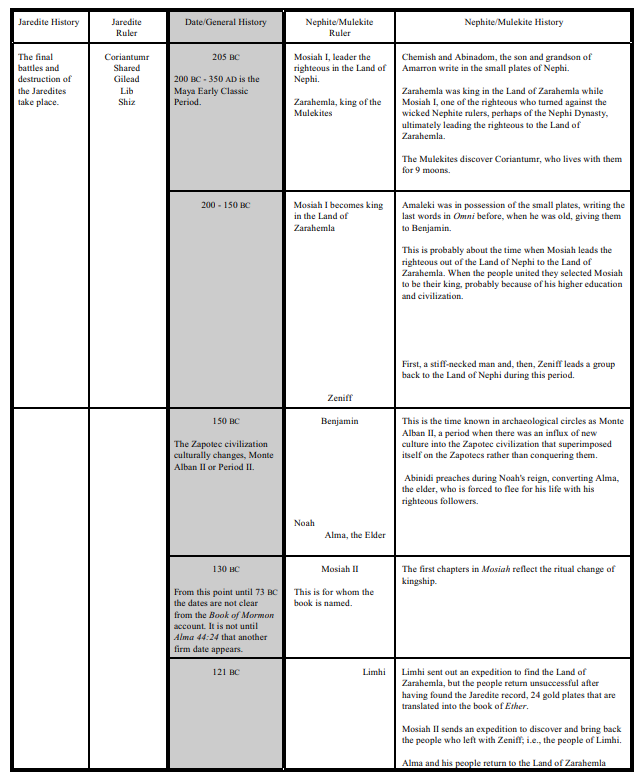Omni
Omni.
Important historical information is contained in Omni, information that enables a time line to be estimated for this early period of the Book of Mormon. In addition, information about the principal players of these books can also be deduced from what is written. For example, Enos’ age when he was charged by his father to care for the plates: he was probably about fifteen because the time line is not otherwise plausible; the time line that follows is heavily dependent upon the information contained in this book.
The period of time covered by Omni, about one-hundred years, is a period of such decay and waywardness that the righteous, by about 300 BC, are forced to flee into the wilderness for their safety. The conditions had to have deteriorated to a point similar to the flight of Nephi and his brothers from Laman and Lemuel some two-hundred fifty years earlier and the flight of Lehi from Jerusalem some three-hundred years earlier. This theme recurs in the Book of Mormon.1
The final historical note in the book is the reference to the people that left Zarahemla to possess the land of their inheritance, the Land of Nephi. This is almost a passing reference at the end of the book, but ties the people Zeniff led back to the Land of Nephi and their record into the history of the rest of the Book of Mormon.2
There is, finally, an important testimony at the end of the small plates, the testimony of Amaleki. Amaleki succinctly states the essence of the gospel:
And it came to pass that I began to be old; and, having no seed, and knowing king Benjamin to be a just man before the Lord, wherefore, I shall deliver up these plates unto him, exhorting all men to come unto God, the Holy One of Israel, and believe in prophesying, and in revelations, and in the ministering of angels, and in the gift of speaking with tongues, and in the gift of interpreting languages, and in all things which are good; for there is nothing which is good save it comes from the Lord; and that which is evil cometh from the devil. And now, my beloved brethren, I would that ye should come unto Christ, who is the Holy One of Israel, and partake of his salvation, and the power of his redemption. Yea, come unto him, and offer your whole souls as an offering unto him, and continue in fasting and praying, and endure to the end; and as the Lord liveth ye will be saved.[efn_oe]Pmni 25–26[/efn_note]
Time-Line Comparison of Civilizations Contemporaneous with Nephites. 


The foregoing chart refers briefly to Zeniff and the people that returned to the Land of Nephi. A more detailed discussion of these people set forth in conjunction with Mosiah 9.
The foregoing chart, also, shows the Mulekites in the Land of Zarahemla, but there is little detail regarding the departure of these people from the land of Jerusalem and why it was that they referred to themselves using Mulek’s name. The historicity of Mulek and his people, however, has been the subject of a great deal of writing. For instance:
Concerning Mulek’s existence, the Bible offers important evidence. Mulek is a nickname derived from melek (Hebrew, king), a diminutive term of endearment meaning “little king.” Its longer form occurs in the Bible as Malkiyahu (in English, Malchiah), meaning “Jehovah is king.” Malchiah is identified as “the son of Hammelech” in Jeremiah 38:6. But Hammelech is a translator’s error, since ben-hammelek means “son of the king” and is not a proper name–a fact confirmed by the Septuagint (LXX Jer. 45:6). A fictive paternity thus obscures the lineage of Malchiah as the actual son of Zedekiah. It is also known that names ending in -yahu (in English, -iah) were common during the late First Temple period, that Zedekiah indeed had a son named Malkiyahu (Aharoni, p. 22), and that the familial forms of yahu-names were shorter than their “full” forms. The study of a seal owned by Jeremiah’s scribe shows that his full name was Berekyahu (in English, Berechiah), although the biblical text uses only the shorter Baruch (Avigad). This is consistent with viewing the hypocoristic Mulek as the diminutive of Malkiyahu, since a is often assimilated to o or u in the vocalic structure of most Semitic languages. It is therefore possible that the Mulek of the Book of Mormon is “Malchiah, son of the king” mentioned in Jeremiah 38:6.3
Words of Mormon. The Words of Mormon includes a transition Mormon wrote between the small plates and his abridgement of the large plates. It, also, appears, to include part of the original translation of the small plates, the last part of Words of Mormon beginning with either verse twelve or thirteen. The last six or seven verses of Words of Mormon, in other words, appear out of place stylistically and substantively. They do not appear to be a transition; rather and more likely, they were originally part of the translation of Mosiah’s book. The part of the book of Mosiah that should precede these verses must have been part of the one-hundred sixteen pages lost by Oliver Cowdery.
The one-hundred sixteen pages. How the original manuscript was written provides an explanation of why the first part of Mosiah is missing in the present-day Book of Mormon, and the way Oliver Cowdery prepared the printer’s manuscript explains how it is that Mosiah begins where it does in the Book of Mormon.
Editorial prerogatives. The editorial prerogatives exercised by Mormon are the subject of an article by Grant R. Hardy, “Mormon as Editor,” contained in Sorenson, John L. and Thorne, Melvin J., Rediscovering the Book of Mormon (Salt Lake City and Provo, UT: Foundation for Ancient Research and Mormon Studies, 1991) at 15.
Endnotes
- E.g., Alma, the elder, at the Waters of Mormon; Limhi and his people; etc
- Mosiah 9:22
- Encyclopedia of Mormonism, vol. 2, s.v. Mulek